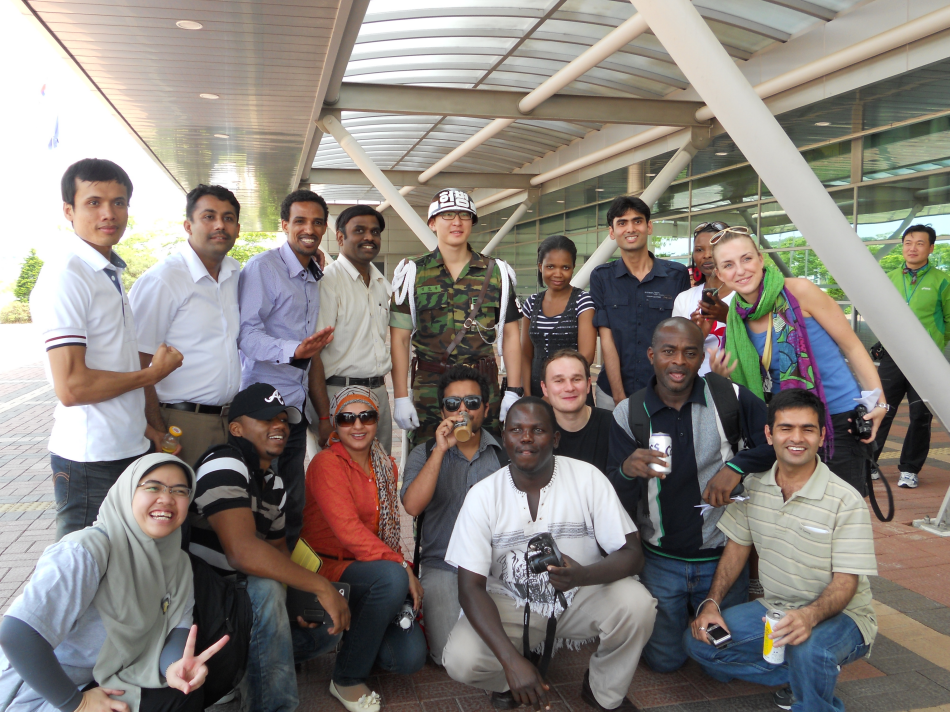
The Visit to the Demilitarized Zone
- Date 2011-08-01 05:51
- CategoryNews
- Hit1530
By Natasa VUJOVIC (2011 MPP, Serbia)
International students have taken a great interest in the distress that modern Korea is under – the unification issue. The Demilitarized Zone (DMZ) has been almost a fixation for many as the seemingly perfect country is struggling with the separation from its twin state. How does it look like? How is it being governed? How big is it? Can we take photos?
On June 11, 2011 two full buses of international students have embarked on this long awaited tour. The tour guide explained the history behind the DMZ instatement and its current governance. While still on the road to the border we were able to see glimpses of bare North Korean mountains stretching across the rich South Korean counterparts. We were told the reason behind the bare mountains was North Korea’s need for fire woods.
The schedule for the day was to visit the Park of Peace, Dorasan Station, Dora Observatory, and the Third Tunnel. The Park of Peace was made to signify the South Korea’s desire for peace and prosperity of all the Korean people. This park is placed right next to the fences of the demilitarized zone and is overlooking the military posts, as well as some houses of the South Korean families who chose to live behind these military gates. The students had the opportunity to explore all these symbols while overlooking the old fashioned wired fences. At the center of the park an old rusted locomotive full of bullet holes was placed on a railway to depict the severity of the Korean War and its magnitude of destruction. It also represents a hope that one day the trains will be able to operate across both countries without constraints. It is a reminder of South Korea’s yearning to open paths for peace and reconciliation toward North Korea. This park is visited by Korean people of all ages, to remember their long lost relatives who happened to be on the other side of the country at the time of the division.
Dorasan Station is a railroad station that once connected North and South Korea. This station had been in function from December 1, 2007 until December 11, 2008 as the trains were transporting raw materials to North Korea and bringing back manufactured goods to South. Unfortunately, after only a year it was closed due to a political dispute between the two. Today, this station is open only for tourism purposes and remains as an indication of the South Korea’s endeavor to establish a connection with its other half.
After visiting the station we moved on to the Dora observatory. This is the closest point to the North Korea and visitors can catch a rare glimpse of the North Korea’s land through the large glass windows or binoculars. The students were very excited to be able to look at the country that has been closed to international public for so long. Unfortunately, as the binoculars were not available on that day we could not see the North Korea propaganda village, a remnant of the old prosperity of the North. The excitement of seeing the North was even greater as the soldiers shouted that no photo was allowed and checked the cameras of all the people who were trying to break this rule. In the anticipation of seeing the Third Tunnel the observatory view helped us visualize where we will be going into during our underground exploration.
The Third Korean Infiltration Tunnel served as a real reminder of how seriously dangerous relations the two countries were and still are in with each other. This tunnel connects the two countries and is only 44 km from Seoul. This was the third tunnel to be discovered running under the border between the two Koreas. This tunnel was discovered in October 1978 based on the information provided by a defector. Lying about 73km below the ground, it is 1.7 km long, 2 m high and 2 m wide. It was designed for a surprise attack on Seoul by the North Korean forces and can easily accommodate 30,000 men per hour with light weaponry. The steep entry, built by the Hyundai Corporation, led to the actual tunnel, The tunnel was very crowded with tourist site and it was challenging to really explore the site. At the end of the allowed route there were three barricades set up by the military and only the first and second are visible to the tourists.
Even though only four tunnels have been discovered to date, there are believed to be about 20 tunnels in total. South Korean soldiers regularly drill in hopes of finding other claimed tunnels.
The visit to the DMZ zone has been a real eye opener for the international students to see how close and serious the relationship between the two Koreas is. At the same time, knowing that these are the same people separated by the will of fate wakened sadness on our way back. Another thing we will always remember is the young soldiers who were guarding us that day. They were extremely friendly, waving at us whenever we would pass by and willing to take photos with everyone, but they were really diligent in maintaining our safety and that was never compromised.



Related News
No Contents.
